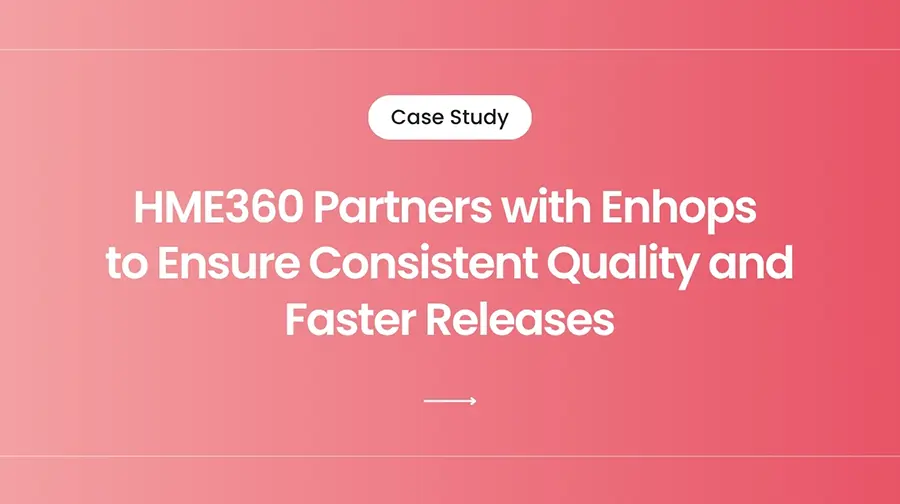TL;DR
Join us as we delve into the importance of sanity and regression test automation and how it can enhance your software development lifecycle. In this blog, we will cover the following sections:
At Enhops, we understand that the key to delivering exceptional software lies in the robustness of testing processes. In the fast-paced world of software development, ensuring the stability and reliability of each release is paramount. This is where teams need to invest and build sanity and regression test suites.
By leveraging automated test suites, we can efficiently verify new builds and ensure that recent changes do not disrupt existing functionalities. Over several projects, I’ve noticed that while many teams have automated tests, the distinction between sanity and regression testing is often blurred or overlooked.
This results in redundant test runs, missed critical defects, and delayed releases. Having clear, automated sanity and regression test suites helps ensure stability, speed, and confidence before every deployment.
Sanity vs. Regression Testing: Key Differences
Both sanity and regression testing are essential to ensure product stability, but they serve different purposes.
Sanity tests act as quick health checks for new builds, while regression tests validate that recent changes haven’t impacted existing functionality. Understanding these differences helps teams save time, reduce noise, and release with confidence.
- Purpose
- Sanity Testing: Quickly verifies key functionalities after a new build.
- Regression Testing: Ensures recent changes haven’t broken existing features.
- Scope
- Sanity: Narrow — focuses only on impacted modules or critical workflows.
- Regression: Broad — covers all major features and system integrations.
- Execution Frequency
- Sanity: Run frequently, often after every build.
- Regression: Run periodically, typically before major releases or overnight.
- Time Required
- Sanity: Lightweight and fast (ideally under 15–20 minutes).
- Regression: More comprehensive, may take several hours depending on coverage.
- Test Case Count
- Sanity: Limited to essential, high-value scenarios.
- Regression: Extensive, with a wide range of functional and integration tests.
- Objective
- Sanity: Build acceptance — “Is the build stable enough for further testing?”
- Regression: Product assurance — “Is everything still working as expected?”
Challenges in Maintaining Sanity and Regression Tests
Many QA teams invest time in building automation frameworks but don’t define what qualifies as sanity vs. regression tests. This lack of structure leads to inefficient testing cycles and unpredictable release outcomes.
Some common patterns observed:
- Sanity tests (the quick health checks) often evolve into mini-regressions, increasing execution time.
- Regression suites grow without pruning — obsolete or irrelevant test cases remain, creating noise and false failures.
- Automation runs happen post-build instead of being integrated early in the CI/CD pipeline.
- Teams don’t always maintain traceability between user stories, test cases, and automation scripts.
The result is teams losing trust in their automation outcomes, relying again on manual smoke checks — defeating the purpose of automation entirely.
Is Your Test Automation Slow or Unreliable?
Enhops helps eliminate flaky tests, optimize frameworks, and improve CI/CD integration.
Risks of Overlooking Sanity and Regression Testing
Without proper sanity and regression automation, releases can slip through with undetected functional issues.
- Technical risk: Broken builds or deprecated features remain undetected until late stages.
- Business risk: Increased turnaround time, lower release confidence, and reduced customer satisfaction.
- Operational impact: QA and Dev teams spend more time triaging test failures than improving coverage or quality.
Best Practices for Sanity and Regression Test Automation
To regain control and confidence in test automation, teams should:
- Define clear boundaries: Sanity tests = critical workflow checks; Regression tests = broader functional validation.
- Automate with intent: Keep sanity suites under 15–20 minutes; ensure regressions run on stable builds only.
- Integrate early: Run sanity tests in every CI pipeline trigger; schedule regressions nightly or pre-release.
- Maintain test hygiene: Review and retire outdated test cases every sprint or release cycle.
- Leverage reporting tools: Use dashboards like Allure or Extent to track flaky tests and test coverage trends.
- Close the loop on defects: Convert newly identified defects into automated test scripts and add them to the regression suite, so they’re validated in subsequent runs.
Implementing these steps not only improves release quality but also builds confidence among developers and stakeholders that automation is truly delivering value.
Benefits of Sanity and Regression Test Automation
Proper automation doesn’t just catch defects — it actively enables faster, more confident releases:
- Immediate Feedback on Builds: Sanity tests catch showstoppers early, so teams don’t waste time downstream.
- Comprehensive Coverage Without Delay: Regression suites validate the product fully and consistently.
- Reduced Manual Bottlenecks: QA can focus on exploratory testing instead of repetitive checks.
- Faster Decision-Making: Clear pass/fail results allow rapid go/no-go decisions.
- Predictable, Reliable Releases: Structured automation makes release cycles smoother and more confident.
Ready to Optimize Your Sanity & Regression Testing?
Enhops can help you build fast, reliable, CI/CD-ready automation suites.
How Enhops Helps You Build Better Sanity & Regression Test Suites
At Enhops, we champion a structured approach to test automation, ensuring that every build is validated quickly and thoroughly, and that no critical defect slips through the cracks.
By defining clear boundaries between sanity and regression suites, integrating automation early in the CI/CD pipeline, and maintaining rigorous test hygiene, Enhops empowers teams to achieve faster feedback, comprehensive coverage, and predictable release cycles.
With Enhops, you gain a trusted ally dedicated to elevating your software quality, accelerating your delivery timelines, and building lasting confidence among stakeholders. Let us help you transform your testing processes and unlock the full potential of automation for your organization.




